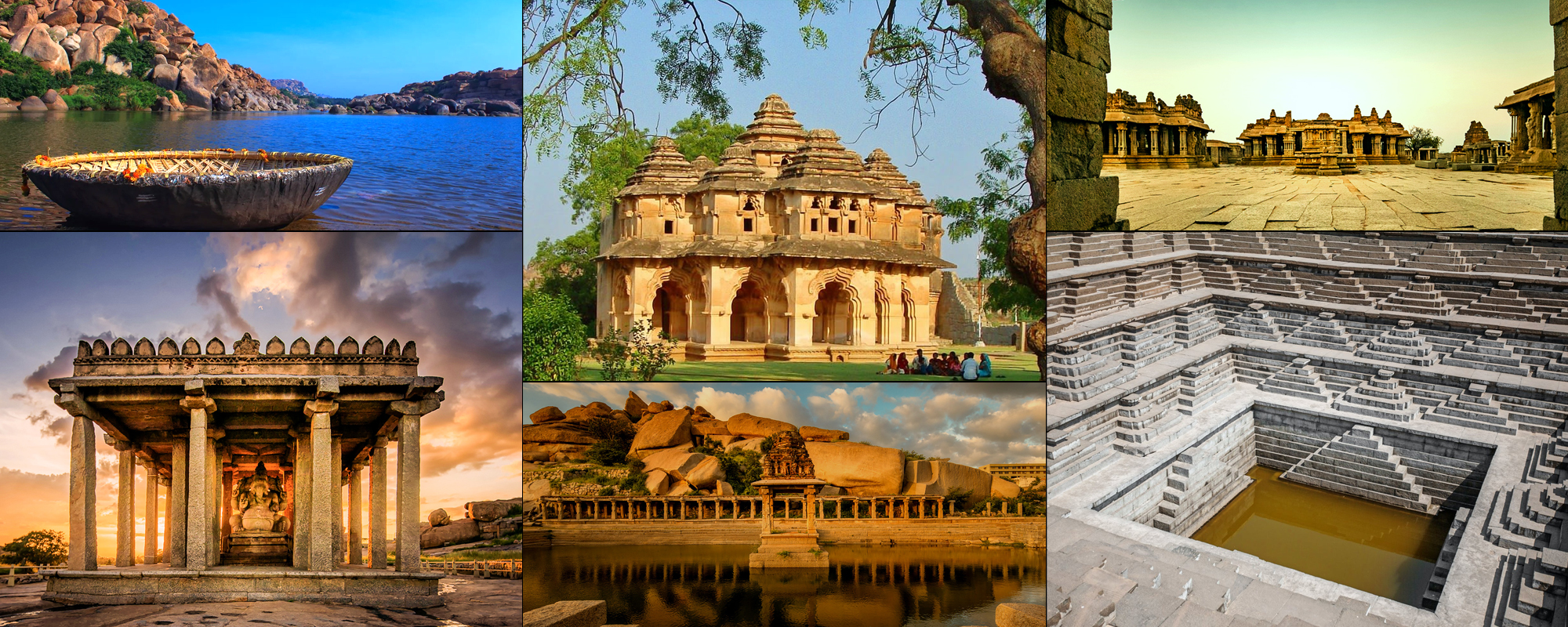
A magnificent historical site of ancient times, Hampi was the original capital of the famous historical Vijayanagara Empire. It is about 11 km away from Hospet City on the Tungabhadra River. A small area of 25 square kilometers, Hampi is surrounded by mountains (Anjaneya, Malyavanta and Matanga Hills) at three of its sites, and the Tungabhadra River borders one of its sites.
In pre-ancient times (around 1 CE), Hampi was known as Kishkindha and the city was ruled by monkeys (according to the Ramayana).
Due to its designation as a World Heritage Site, Hampi attracts thousands of visitors every year, making tourism a major source of income for the local economy. Besides its opulent manganese and iron ores, Hampi's sound agriculture and culture are major factors of its wealth. The cultural and religious festivals held here are among the most significant aspects of Hampi's culture.
There are several unique celebrations in Hampi, including Vijaya Utsav, Purandara Festival, and Virupaksha Car Festival, in addition to the traditional Indian festivals.
Among the sublime mementos of ostentatious yore set against the backdrop of the Vijaya Utsav, commonly known as Hampi Festival, the most important event is commemorated here. Traditionally, this cultural carnival is held during the first week of November for three days, organized by the Karnataka government. During this season of festivity, Hampi is crowded with tourists as the atmosphere is loaded with ultimate fun and excitement.
In addition to puppet shows, drama, musical concerts, fireworks, and a grand procession, Vijaya Utsav certainly recreates the legacy of the Hampi royal heritage. A magical symphony of art and culture is created here by proficient artists from different parts of the country. Vijaya Utsav, a continuation of the 'Nada Utsav' celebrated in the past, is a celebration of excellence.
The Purandara Festival is a tribute to Hampi's musical heritage, and the Virupaksha Car Festival is another notable event in Hampi apart from the august Vijaya Utsav. The Utsav commemorates the ingenuity of Indian classical music by hosting it in the last week of January or the first week of February.
It marks the birth anniversary of Purandara Dasa, the father of Carnatic music, who was baptized at Hampi's holy temple of Lord Vittal. Virupaksha Car Festival is the most grandiose festival of Hampi, which celebrates the vernacular tradition of the betrothals of many Gods and their wives. It is organized every year in April or March.
The Mauryan Empire used Hampi as a seat of power in the third century BC. A place of such magnificence and opulence is bound to have a rich cultural heritage as well. As far as Ashoka's times were concerned, rock edifices in the Bellary district were a common method of recording significant information.
In 1336 AD, the Vijayanagara Empire was founded by King Krishnadeva Raya, who led his dynasty to unprecedented heights under the leadership of AD.the Tuluva Dynasty. Hampi was the capital city of all four of these dynasties together.
Known for its association with the epic Ramayana, Hampi has a legend that is attached to the 'Kishkindha Kaand', one of the 'Kaands' in Ramayana.
Legend says that this episode occurred when Lord Rama and Lord Lakshman reached Hampi, which is confirmed by many geographical evidences.
Hampi is a UNESCO heritage site and is a well-preserved tourists spot of olden ruins. Several ancient monuments and temples from the Mauryan and Vijayanagar empire can be seen here, and the city still hold the charm of the bygone days with a serene atmosphere and stunning landscape.
Some of the top places to visit in Hampi are: Virupaksha temple, Vithala temple, Lotus Palace, Yantrodharaka Hanuman Temple, Hampi Bazaar, and Hippie Island.
Hampi is in the southern state of Karnataka.
Hampi was founded by Harihra I and Bukka Raya I of the Sangama Dynasty in 1336 AD.
There are numerous hotels and heritage resorts near Hampi where you can stay during your tour.
Hampi was destroyed during the battle of Talikota in 1565, which was a coalition of Muslim Sultanates with the Vijayanagar empire. They caught and beheaded the king Aliya Rama Raya and demolished a major portion of the architecture and infrastructure fabric of Hampi and the metropolitan Vijayanagar.
Copyright 2012-2022 Indiamap Digital Pvt Ltd. All rights reserved. Privacy Policy | Terms of Use